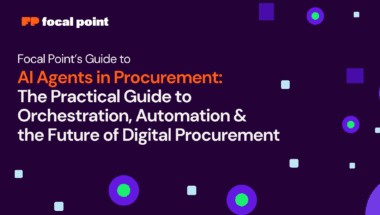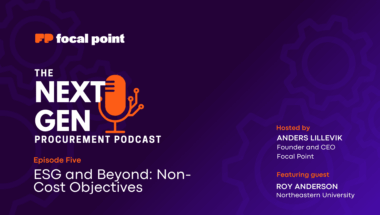By Matthew Buckingham
The Smartphone Analogy: A Familiar Problem
Imagine your phone without an operating system. No iOS. No Android. Just a collection of apps floating on their own, disconnected and disorganized. You could still open them, but they would not communicate, update properly, or share data. Notifications would be missed. Features would clash. The experience would be frustrating and chaotic.
This is what procurement looks like inside many enterprises today. Dozens of tools for sourcing, contracting, performance management, analytics, and collaboration. None of them work particularly well together. The result is digital clutter masquerading as digital transformation.
Procurement teams are not struggling due to a lack of software. They are struggling because their software has no underlying structure. And this fundamental issue is preventing the function from operating at its full potential.
Procurement’s Fragmentation Problem
Across industries, procurement teams have tried to modernize by layering tools on top of one another. The logic was simple: digitize the process, automate some workflows, and get data out of spreadsheets. But the result has been far from elegant.
One tool manages sourcing events. Another handles contract approvals. Dashboards track supplier KPIs. Intake requests live in portals. Conversations bounce between email, chat, and shared drives. Add in spreadsheets for tracking what the systems cannot handle, and the outcome is clear. Instead of clarity, teams are dealing with tool chaos.
This fragmentation introduces several hidden costs. Manual workarounds have become the norm. Information is duplicated or lost in transit. Visibility into spend, risk, or performance is partial at best. Onboarding and adoption lag because users are forced to navigate a maze. AI tools fail to deliver results because the inputs are messy, incomplete, or siloed.
The problem is not a lack of digital tools. The problem is the absence of an intelligent layer to unify them.
Why Procurement Needs an Operating System
Procurement does not need another app. It needs an operating system. A foundational structure that brings everything together and makes sense of the entire landscape.
An operating system in this context is not a single application. It is a cohesive environment that supports how procurement teams intake requests, execute work, enforce compliance, and measure outcomes. It connects tools, guides workflows, synchronizes data, and delivers context across the lifecycle of a project or process.
Think of it as a shared backbone. Instead of forcing users to jump between tabs and systems, it allows them to operate within a unified, permissioned, and intuitive space. The experience becomes less about managing software and more about making decisions.
Key features of this kind of operating system include:
- A centralized hub where intake, execution, and collaboration are orchestrated
- A unified data model that ensures consistency across reports, audits, and dashboards
- Embedded compliance, approvals, and governance built into daily workflows
- A shared user interface that reduces learning curves and improves usability
- Native support for automation and AI, driven by high-quality, structured, secure and validated data
This approach changes the role of procurement software from task-specific tools to a connected environment for strategic decision-making.
Why Now? The Timing Matters
This shift is not just a nice idea. It is quickly becoming essential. There are three major forces making the operating system model more urgent than ever.
1. AI Demands Structure
Procurement leaders are being pitched dozens of AI tools. Intelligent sourcing, contract review, risk scoring, and more. But AI is only as good as the data and context it receives. Without an integrated foundation, these tools generate more noise than value. An operating system ensures that AI agents operate from the same playbook and data, improving both outcomes and accountability.
2. Compliance Is Growing More Complex
ESG regulations, supplier diversity goals, and data privacy rules are not going away. In fact, they are intensifying. Compliance now requires real-time visibility and traceability across supplier ecosystems. Fragmented systems simply cannot keep up. Procurement teams need a cohesive architecture that makes compliance automatic rather than reactive.
3. Agility Requires Architecture
Procurement is no longer a back-office function. Supply chain shocks, economic pressure, and shifting business priorities demand fast, coordinated responses. Teams must pivot quickly, reroute spend, onboard new vendors, or rework contracts without waiting on IT to stitch together another short-term solution. An operating system gives procurement the flexibility to adapt at scale.
What to Look for in a Procurement Operating System
For organizations considering this shift, it is important to look beyond the label. Many vendors may claim to be a platform, but few actually deliver the depth and cohesion required to function as an operating system.
Key traits to look for include:
- A true centralized hub for all procurement activity, not just intake or approvals
- Real-time analytics that tie directly into workflows, not disconnected dashboards
- Seamless integration with existing ERP, CLM, and sourcing systems
- Transparent governance and risk monitoring built into daily activity
- No-code configuration options to support agility without overloading IT
Most importantly, the solution should not feel like another tool layered on top of existing problems. It should feel like a simplifying force that brings clarity, not more clutter.
Beyond Procurement: A Preview of What’s Coming
Procurement may be the first enterprise function to face this reckoning, but it will not be the last. Finance teams are battling disconnected systems for forecasting and budget control. HR teams are buried in point solutions for recruiting, performance, and compliance. Operations teams are juggling workflows between internal tools and external partners.
All of them are reaching the same conclusion. Fragmented point solutions cannot solve structural problems.
The future of enterprise software is not defined by who has the most features, or who is the most difficult to off board. It is going to be driven by whoever provides the strongest foundation. One that is flexible, connected, intuitive and built for scale.
Procurement is showing us the path forward. Not with more apps, but with the right architecture.



